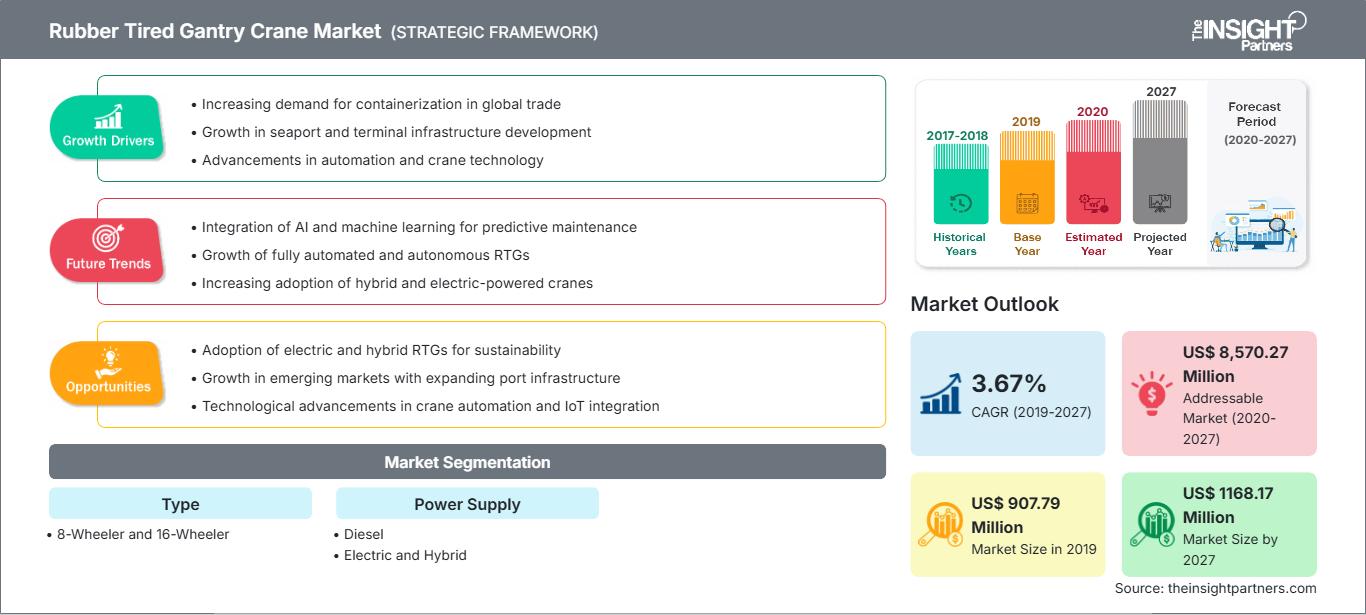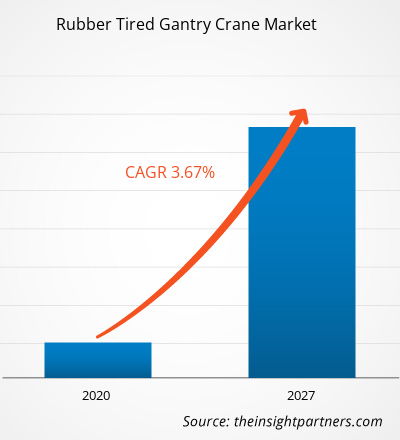Le marché des portiques sur pneus était évalué à 907,79 millions USD en 2019 et devrait atteindre 1 168,17 millions USD d'ici 2027 ; il devrait croître à un TCAC de 3,67 % entre 2020 et 2027.
Par le passé, les pays en développement étaient des fournisseurs de matières premières ; cependant, la structure des échanges commerciaux a donné un nouveau rôle aux pays en développement du monde entier, grâce à quoi le marché des portiques sur pneus devrait connaître un taux de croissance significatif au cours de la période de prévision. Cette croissance du marché est principalement attribuée à l'augmentation de la demande de commerce maritime, car les pays en développement, dont la Chine, émergent désormais comme d'importants importateurs et exportateurs de marchandises par voie maritime, l'Asie étant la plus grande région commerciale.
De plus, le marché des portiques sur pneus est stimulé par des initiatives gouvernementales favorables au développement des ports. Un port devient un rouage essentiel de l'économie s'il fonctionne correctement. Aujourd'hui, la vocation d'un port ne se limite plus à une simple plateforme logistique. La productivité d'un port est importante pour le commerce international, car un port maritime est le nerf du commerce extérieur d'un pays. Plusieurs politiques gouvernementales sont mises en œuvre, ce qui stimulera le marché mondial des portiques sur pneus au cours de la période de prévision.
L'Europe a dominé le marché des portiques sur pneus en 2019 et devrait maintenir sa domination au cours de la période de prévision. Les ports européens ont adopté des portiques électriques pour réduire la pollution et les émissions de gaz à effet de serre. Les réglementations gouvernementales de la région ont permis l'adoption d'équipements électriques de manutention de conteneurs, notamment pour la vérification des émissions de carbone dans le transport maritime. L'Europe représente un volume important d'échanges de produits et d'actifs, tels que les machines, les véhicules, les avions, les carburants, les métaux non ferreux, les textiles, les produits chimiques, les vêtements et le pétrole brut. L'Europe occupe la première place en termes d'échanges, ce qui lui permet de dominer le marché mondial des portiques sur pneus.
Personnalisez ce rapport en fonction de vos besoins
Vous bénéficierez d’une personnalisation sur n’importe quel rapport - gratuitement - y compris des parties de ce rapport, ou une analyse au niveau du pays, un pack de données Excel, ainsi que de profiter d’offres exceptionnelles et de réductions pour les start-ups et les universités
Marché des grues à portique sur pneus en caoutchouc: Perspectives stratégiques

- Obtenez les principales tendances clés du marché de ce rapport.Cet échantillon GRATUIT comprendra une analyse de données, allant des tendances du marché aux estimations et prévisions.
Impact de la pandémie de COVID-19 sur le marché des portiques sur pneus
Vous bénéficierez d’une personnalisation sur n’importe quel rapport - gratuitement - y compris des parties de ce rapport, ou une analyse au niveau du pays, un pack de données Excel, ainsi que de profiter d’offres exceptionnelles et de réductions pour les start-ups et les universités
Marché des grues à portique sur pneus en caoutchouc: Perspectives stratégiques

- Obtenez les principales tendances clés du marché de ce rapport.Cet échantillon GRATUIT comprendra une analyse de données, allant des tendances du marché aux estimations et prévisions.
La crise de la COVID-19 affecte les industries du monde entier et l'économie mondiale devrait être la plus touchée en 2020 et 2021. L'épidémie a provoqué d'importantes perturbations dans les secteurs primaires tels que l'électronique grand public, les semi-conducteurs, l'automobile et les infrastructures informatiques. Toutes ces industries sont cruciales pour la croissance du marché mondial des portiques sur pneus, car elles constituent les principales sources de demande pour ce type de grues. Les fermetures d'usines, les interdictions de voyager, les interdictions commerciales et les fermetures de frontières ont eu un impact sur la fabrication et la vente de divers produits et composants électroniques grand public. L'industrie mondiale de l'électronique et des semi-conducteurs est l'une des principales industries confrontées à de graves perturbations en raison de problèmes de chaîne d'approvisionnement et d'arrêts de production.
Analyse du marché : attention croissante portée aux technologies vertes
Les acteurs du marché se concentrent sur les technologies vertes en raison des réglementations gouvernementales strictes concernant la pollution et les limites d'émissions dans diverses régions. De plus, l'utilisation de portiques à roues à roues (RTG) équipés de moteurs électriques peut être optimisée pour consommer moins d'énergie. L'utilisation de la technologie hybride à batterie sur les grues permettra de réduire considérablement la consommation de carburant et les émissions nocives de combustibles fossiles. Environ 10 % des émissions de diesel des équipements de manutention portuaire sont émises par les portiques à roues à roues ; la mise en œuvre de portiques à roues à roues plus performants réduit directement l'impact environnemental de leurs opérations. Cette technologie est une solution pour les opérateurs portuaires du monde entier qui souhaitent accroître leur efficacité tout en réduisant leurs émissions et l'impact environnemental de leurs opérations. Elle offre également des avantages supplémentaires en termes de réduction des coûts d'exploitation, de réduction des émissions de gaz à effet de serre et de réduction du bruit au terminal. Technologie de stockage d'énergie par volant d'inertie pour portiques à pneus (RTG) pouvant être installés ultérieurement sur des portiques à roues à roues existants ou intégrés à une nouvelle construction. Les volants d'inertie permettent de réduire la consommation de carburant et les émissions en captant l'énergie de freinage produite lors de la descente d'un conteneur.
Analyses du marché par type
Selon le type, le marché mondial des portiques sur pneus peut être divisé en deux segments : les portiques à 8 roues et les portiques à 16 roues. Il existe deux types pour chaque modèle : les portiques à 8 roues (8W et 8WA) et les portiques à 16 roues (16W et 16WA). Les principales différences entre les deux modèles résident dans la conception du système anti-balancement et le nombre de roues du portique. Les portiques RTG à 16 roues nécessitent une plus grande surface de déplacement. Elles ne peuvent donc pas être utilisées dans les espaces restreints. Les portiques RTG à 8 roues sont préférables pour les espaces plus restreints.
Analyses du marché par alimentation électrique
Selon l'alimentation électrique, le marché mondial des portiques sur pneus peut être classé en trois catégories : diesel, électriques et hybrides. La mise en œuvre de normes d'émission strictes pour minimiser les émissions mondiales et le développement de véhicules électriques plus performants, ainsi que la hausse des prix du carburant, devraient stimuler la demande de grues RTG électriques et hybrides à l'échelle mondiale. Les grues RTG électriques offrent de meilleures performances et peuvent déplacer des charges importantes. De ce fait, la préférence pour les portiques sur pneus électriques et hybrides devrait augmenter prochainement.
Le développement de produits est l'une des stratégies les plus couramment adoptées par les entreprises pour élargir leur portefeuille de produits. Anupam Industries Limited, Electromech Material Handling Systems (India) Pvt. Ltd, Konecranes, Liebherr et Kalmar comptent parmi les principaux acteurs qui mettent en œuvre des stratégies pour élargir leur clientèle et conquérir une part significative du marché des portiques sur pneus, ce qui leur permet de maintenir leur marque sur le marché mondial.
Marché des grues à portique sur pneus en caoutchouc
Les tendances et facteurs régionaux influençant le marché des grues à portique sur pneus tout au long de la période de prévision ont été analysés en détail par les analystes de The Insight Partners. Cette section aborde également les segments et la répartition géographique du marché des grues à portique sur pneus en Amérique du Nord, en Europe, en Asie-Pacifique, au Moyen-Orient et en Afrique, ainsi qu'en Amérique du Sud et en Amérique centrale.Portée du rapport sur le marché des grues à portique sur pneus en caoutchouc| Attribut de rapport | Détails |
|---|---|
| Taille du marché en 2019 | US$ 907.79 Million |
| Taille du marché par 2027 | US$ 1168.17 Million |
| TCAC mondial (2019 - 2027) | 3.67% |
| Données historiques | 2017-2018 |
| Période de prévision | 2020-2027 |
| Segments couverts |
By Type
|
| Régions et pays couverts | Amérique du Nord
|
| Leaders du marché et profils d'entreprises clés |
|
Densité des acteurs du marché des grues à portique sur pneus : comprendre son impact sur la dynamique des entreprises
Le marché des portiques sur pneus connaît une croissance rapide, porté par une demande croissante des utilisateurs finaux, due à des facteurs tels que l'évolution des préférences des consommateurs, les avancées technologiques et une meilleure connaissance des avantages du produit. Face à cette demande croissante, les entreprises élargissent leur offre, innovent pour répondre aux besoins des consommateurs et capitalisent sur les nouvelles tendances, ce qui alimente la croissance du marché.
- Obtenez le Marché des grues à portique sur pneus en caoutchouc Aperçu des principaux acteurs clés
Segmentation du marché des grues à portique sur pneus en caoutchouc :
Par type
- 8 roues
- 16 roues
Par alimentation électrique
- Diesel
- Électrique
- Hybride
Profils d'entreprise
- Anupam Industries Limited
- ELECTROMECH MATERIAL HANDLING SYSTEMS (INDIA) PVT. LTD
- Kalmar
- Konecranes
- Liebherr
- Produits Mi-Jack.
- REVA INDUSTRIES LTD
- Shanghai Zhenhua Heavy Industries CO., Ltd. (ZPMC)
- TNT Crane & Gréement
- Groupe Sany
- Analyse historique (2 ans), année de base, prévision (7 ans) avec TCAC
- Analyse PEST et SWOT
- Taille du marché Valeur / Volume - Mondial, Régional, Pays
- Industrie et paysage concurrentiel
- Ensemble de données Excel
Rapports récents
Témoignages
Raison d'acheter
- Prise de décision éclairée
- Compréhension de la dynamique du marché
- Analyse concurrentielle
- Connaissances clients
- Prévisions de marché
- Atténuation des risques
- Planification stratégique
- Justification des investissements
- Identification des marchés émergents
- Amélioration des stratégies marketing
- Amélioration de l'efficacité opérationnelle
- Alignement sur les tendances réglementaires




















 Obtenez un échantillon gratuit pour - Marché des grues à portique sur pneus en caoutchouc
Obtenez un échantillon gratuit pour - Marché des grues à portique sur pneus en caoutchouc